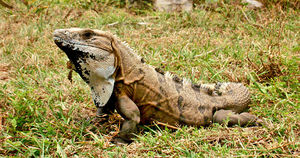Spiny-tailed Iguana
| This article has been peer reviewed but is awaiting expert review. If you would like to help with this, please see more information about expert reviewing. |
Scientific name: Ctenosaura spp. (10 spp.) (e.g. C. pectinata & C. similis)
Description
Spiny-tailed iguanas are large, bulky lizards with adult males reaching up to 1.1m in length. They are predominantly black but the dorsal surface may show black bands on a greyish background. The colour may also lighten after basking with yellowish and orange markings becoming evident along the sides. Adult males have well-developed dorsal crests and dewlaps. Females lack obvious crests. There is considerable variation with age and sex and therefore identification may be difficult. Both species may have a keeled tail. Juveniles tend to be olive-green becoming tan and then finally greyish as they grow. These are aggressive lizards and will frequently charge and bite a perceived attacker; they have a formidable bite!
These lizards are fairly demanding in terms of diet, husbandry and disposition and are therefore not recommended for the novice reptile keepers.
Range
- C. pectinata - Mexico
- C. similis - Central America and Mexico
Diet
Ctenosaurs should be offered a wide variety of foods. They require both animal and plant derived protein. Plant matter should consist of the typical iguana diet (see the green iguana page for details). In addition a large proportion of the diet must include invertebrates (especially insects), small mammals, eggs and chopped meat. Supplementation is essential.
Enclosure
These lizards require large vivariums, surfaces to climb and plenty of cover. They are territorial so avoid overcrowding. There should be no more than one male per enclosure.
Temperature
The daytime temperature on the cooler end of the cage should stay at about 30ºC, and the warm side of the cage should be 35ºC, with a spot directly beneath the basking lamp of up to 40ºC. At night the temperature can drop to 25ºC.
Literature Search
Use these links to find recent scientific publications via CAB Abstracts (log in required unless accessing from a subscribing organisation).
Spiny-tailed Iguana (Ctenosaura spp.) publications

